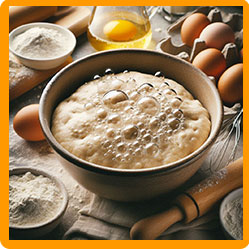
Organic Reactions
Organic chemistry is the study of compounds that contain carbon. In GCSE Chemistry, you’ll learn about some key families of organic compounds, how they react, and how we use them in everyday life and industry. This section covers alkenes, alcohols, carboxylic acids, and esters – and how these different groups are connected through a series of important reactions.
Alkenes and Their Reactions
Alkenes are unsaturated hydrocarbons – this means they have at least one double bond (C=C) between carbon atoms. The general formula for alkenes is CₙH₂ₙ. Common examples include ethene (C₂H₄) and propene (C₃H₆).
- The first four alkenes are ethene (two carbon atoms), propene (three carbon atoms), butene (four carbon atoms), pentene (five carbon atoms).
- Alkenes combust completely in a large amount of oxygen to produce water and carbon dioxide.
- Alkenes react via addition reactions. The double bond opens up to create a single bond. Alkenes can react with Halogens this way.
- Mix alkenes with steam and then pass it over a catalyst to form alcohols.
Because of their double bond, alkenes are more reactive than alkanes and take part in addition reactions, where the double bond opens up and new atoms are added. Important reactions of alkenes include:
- Hydrogenation – adding hydrogen to make an alkane.
- Reaction with halogens – e.g. bromine water goes from orange to colourless.
- Hydration – reacting with steam to produce alcohols, such as ethanol.
Alcohols and Ethanol
Alcohols are organic compounds that contain an –OH functional group. They are widely used as fuels, solvents, and in alcoholic drinks. The first four alcohols are methanol, ethanol, propanol, and butanol.
Ethanol is a particularly important alcohol. It can be produced in two ways:
- Hydration of ethene (a chemical method using steam and a catalyst)
- Fermentation of sugars using yeast in anaerobic conditions (a slower, renewable method used in industry and brewing)
The properties of alcohols:
- Contain an -OH functional group.
- They are flammable.
- Their solutions have a neutral pH.
- They react with sodium.
- They can be oxidised.
- Methanol and ethanol are used as solvents.
- Ethanol is used as fuel in spirit burners, it's clean and non-smelly.
- Ethanol is found in alcoholic drinks, it's made by fermentation.
Revision Notes

The Cornell method is like a supercharged note-taking system that helps you ace your revision!
Print out our blank revision notes pages to help you revise.
How to make effective revision notes with the Cornell method.
Exam Questions & Answers

Download and print off practice our FREE worksheet with exam style questions on Cell Biology.
Carboxylic Acids
Carboxylic acids contain the –COOH functional group. They are weak acids that partially ionise in water and react with bases, carbonates, and metals — producing salts, water, and carbon dioxide. Examples include:
- Methanoic acid
- Ethanoic acid (commonly known as vinegar)
They have many uses in food preservation and as intermediates in chemical reactions.
Esters and Esterification
Esters are formed when a carboxylic acid reacts with an alcohol, in the presence of an acid catalyst such as sulfuric acid. This reaction is called esterification. Esters have distinctive sweet smells and are often used in perfumes, flavourings, and solvents.
Example:
Ethanol + ethanoic acid → ethyl ethanoate + water
Esters are useful, versatile compounds that demonstrate how functional groups combine in organic reactions.
Also see Polymers, Crude Oil & Fuels, Chemical Analysis
Revision Notes

The Cornell method is like a supercharged note-taking system that helps you ace your revision!
Print out our blank revision notes pages to help you revise.
How to make effective revision notes with the Cornell method.
Why Do I Need to Know About Organic Reactions?
In Everyday Life
- Understanding ingredients in products like perfumes, soaps, and food flavourings (e.g. esters and alcohols)
- Knowing how fuels like ethanol are made and used
- Recognising how fermentation works in bread, beer, and biofuels
- Making sense of labels on cleaning products, medicines, and cosmetics
- Being aware of environmental impacts of organic compounds and fuels
In Science & Chemistry Careers
- Designing new materials, fragrances, solvents, and fuels
- Developing pharmaceuticals and understanding how the body processes chemicals
- Working in green chemistry, developing sustainable biofuels or biodegradable plastics
- Researching carbon-based compounds in chemistry, biology, and medicine
- Applying organic reaction knowledge in industries such as cosmetics, food science, and chemical engineering


